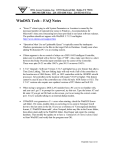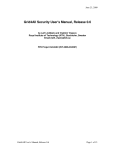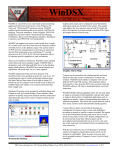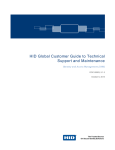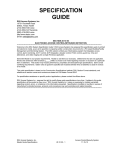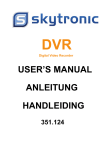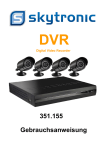Download DSX Access System, Inc. WinDSX System information
Transcript
® WinDSX Update 3.7 / 4.8 AES 256 Communication Encryption Alarm Email / Text Message Notification Comm Server can run as a Service Bulk Modify Access Levels including Temp Embedded Hot Links in Action Messages Threat Level Management Time Zones controlled with Linking Logic Hot-Swap Communications Server Hidden & Predefined User Defined Fields High Level Elevator Control Interface/Report Digital Video Recorder Integration DSX-LAN(M) Interface w/ Modem Backup Unlimited Access Levels per Card Holder Date Controlled Temporary Access Levels Card Holder “Photo Roster” Report “Who Is In” Report Initiated by Input Alarm Route Auto History Reports via Email - SMTP Microsoft Access & SQL Server versions Card Use it or Lose it USB Webcam support for image capture FIPS and TWIC Card Support Active Directory Authentication WinDSX SQL can now utilize complex logins and passwords facilitated by Active Directory in Windows™. Operator Logins can be authenticated by Active Directory instead of WinDSX. When WinDSX SQL receives a login from an operator it sends the login request to Active Directory (AD) for authentication. If AD authenticates the operator they are given access to the system according to the Password Profile assigned to them in WinDSX. 4.8.65 Backup SQL Server This version of WinDSX SQL allows for the definition of both a primary and backup SQL Server and database path. If the primary SQL Server fails the software can be shut down and restarted and it will connect to the backup SQL Server and database path. This feature will facilitate off site backup SQL Servers that cannot use SQL Clustering for redundancy. 4.8.65 AES 256bit Encryption Communication between the DSX Comm Server and the Intelligent Controllers can now be secured using AES 256 bit Encryption. Each location can optionally be encrypted with its own Key. Communications between the Comm Server PC and the Client Workstations can also be assigned an Encryption Key to secure the communications between PCs. 3.7.101 / 4.8.51 Alarm Email Notification Alarms can now be emailed using an SMTP Server. Location, Device, and Inputs can be individually selected to send notification to Email Groups on Alarm. Email Groups can be one or multiple people each with a Time Zone that determines when the alarm can be emailed to that person. Email Groups are built from Card Holders that have an Email address in a designated UDF field. Available in WinDSX Versions 3.7.36 and 4.8.8 and higher. Comm Server runs as a Service With this new WinDSX upgrade you can now have the Communication Server program run as a Service without having a user logged into the Windows™ operating system. This provides the DSX Access Systems, Inc. 10731 Rockwall Road Dallas, Texas 75238 / 888-419-8353 / www.dsxinc.com 12/2010 ability for the Comm Server program to run on a manned or unmanned PC. Comm Server can be configured as a Service with WinDSX Versions 3.7.34 and WinDSX SQL Version 4.8.6 and higher. Keymon can also be run as a Service. Startup Maps / Configurable Map Size WinDSX and WinDSX SQL can now support Maps of varying size. Each Map can have its height and width defined. Workstation can now launch a Map automatically upon startup. This is great for applications where the user wants a Map displayed at all times showing the status of the live input and output Icons. 3.7.114 / 4.8.72 New Access Level Manager WinDSX and WinDSX SQL now come with a new Access Level Manager. This new more efficient manager will create fewer access levels when combining levels across multiple locations. This will reduce the amount of memory required to store access levels in the panels. The trade off is that now when an access level is edited (door add or delete) every card that is assigned that access level will receive a new access level assignment. So editing an access level that is assigned to thousands of cards will cause an incremental update and download of thousands of cards which can take some time to complete. All cards will continue to work during the download but no other downloads can take place until it is complete. You will not see an immediate reduction in the number of access levels, unused access levels will not be removed until the system runs through daily ops at midnight on a Saturday. The first time you login after the upgrade there will be an access level upgrade process. This could take a while but will only occur once. 3.7.101 / 4.8.51 Bulk Modify Access Levels This feature allows the operator to select multiple Card Holders using the normal search and list methods and then add and/or delete Access Levels to all card holders selected at once. Temporary Access Levels can also be modified complete with start and stop dates. USB WebCams USB WebCams replace TWAIN as free option. Embedded Links in Action Message Action Messages can now contain embedded hot links. From the Alarm Acknowledgement Screen you can click on the associated Action Message and with an embedded hot link you can access PDF files or other documents that contain response directives and information. It would also be possible to start Internet Explorer™ and automatically display a webpage or IP Camera. Multiple Dates on Scheduled Override Scheduled Override in Workstation now has a second tab that allows multiple days to be defined for the same override. So if you need to override a door at the same time for the whole work week you could do it in one scheduled override instead of creating 5 separate ones. Threat Level Management With a click of a mouse, press of a button, or presentation of a Card, the system can be instantly reconfigured to coincide with the Homeland Security Advisory System and meet any heightened security requirements. With a single action doors can be locked down, alarm points armed, readers disabled, access levels restricted, image recall invoked and more. The system can be made incrementally more secure with each action and just as quickly put back to normal. Components of the DSX system can be individually enabled or disabled to create the environment the situation requires. DSX Threat Level Management can be customized to meet the specific needs of each customer. Time Zones controlled with Linking DSX can now link to Time Zones as well as Inputs and Outputs. Linking to a Time Zone forces it to be “On or Off” thereby controlling anything it is assigned to. Linking to Time Zones allows the control of Access Levels, Alarm Echo, Devices (readers/keypads), Event Filters, Image Recall, Inputs, Outputs, and Linking Groups. This will provide the ability to address many new applications such as “Snow Days”, “Threat Level Management”, and “Lockdown” just to name a few. This feature requires a Flash update for all controllers. PC Master and Soft I/O must also be upgraded at the same time. DSX Access Systems, Inc. 10731 Rockwall Road Dallas, Texas 75238 / 888-419-8353 / www.dsxinc.com 12/2010 Hot-Swap Redundant Comm Servers Hot-Swap Redundant Communications Servers provides continued availability of System Communications and Control through the implementation of Primary and Backup Communication Server PCs. Available only with WinDSX SQL the Hot-Swap Supervisor runs on the Backup Comm Server and monitors the Primary Comm Server. When the primary fails all communications are redirected to the Backup Comm Server. LAN connected locations are transparently transferred to the Backup Server and with the use of a DSX-SPS Serial Port Switcher all dial-up and direct serial port connected locations are also switched automatically. WinDSX SQL Workstations automatically switch to the backup server and continually display which server they are talking to. This feature requires the purchase of the Hot Swap Supervisor software and optionally the DSX-SPS Serial Port Switcher. WinDSX SQL now has the ability to log into the SQL Server using either network authentication or SQL authentication. This makes the way for Redundant SQL Servers working in a Cluster for high availability of the database. Hidden and Predefined UDFs Sensitive UDF data can now be restricted on a field by field basis. This allows operators to view and manage some UDFs while restricting access to others that may contain sensitive data. Access to the Hidden User Defined Fields is implemented on an individual operator basis. User Defined Fields can now have predefined choices for the operator to select from. High Level Elevator Control Interface WinDSX with the use of DSX-Soft I/O now has the ability to integrate with Elevator systems using a serial data connection instead of relay outputs. WinDSX is configured the same as before but instead of activating a relay output with a Code to Output Link it is activating a virtual output that sends a unique command string to the elevator system telling it to enable a certain floor select button in a particular cab. Using serial data connections instead of relay outputs, provide a simpler install and creates a more efficient and reliable system. Interfaces for OTIS & KONE Elevator Systems are available. Digital Video Recorder Integration WinDSX now has the ability to integrate with various different Digital Video Recorders. This integration allows stored and live video from the DVR to be accessed within the DSX software. All video is transmitted across a Local Area Network connection. Real time video can automatically be displayed in response to alarm events. Additionally the operator can request real time and/or stored video from the alarm acknowledgement screen or from any input/output or camera icon. Recorded Video can also be viewed while running a History report. Simply highlight the event you would like to see the video for and click the “Show Video” button. The system will find the video that matches the event, time and date and display it on screen. Temporary Access Levels DSX now provides the ability to assign temporary access levels to a card. Temporary Access Levels can be assigned to override the Card Holders normal access level on a user defined Start Date and then revert back to the permanent Access Level on a user defined Stop Date. This could be for an employee that would need access to another area temporarily. For instance an employee receives an assignment that will require him to enter the HR department for the next two weeks. He would be given a Temporary Access Level that includes his permanent access levels and the HR department level. The Temporary Access Level assignment would be given a Start Date of ??/??/???? and a Stop Date of ??/??/????. On the Start Date the Temporary Access Level is applied and the Permanent Access Level is suspended until the Stop Date is reached whereby the Permanent Access Level is reinstated. DSX-LAN Communications Interface w Modem Backup DSX now manufactures a LAN communication device to connect with DSX Controllers over a DSX Access Systems, Inc. 10731 Rockwall Road Dallas, Texas 75238 / 888-419-8353 / www.dsxinc.com 12/2010 LAN/WAN. This module is powerful but simple. The unit is Auto-sensing (10/100Mbit) so just plug it in no matter what the speed of the customers Network. Auto-duplexing allows it to work on any router it is connected to. The module is powered by 12VDC from any DSX Controller, which also provides battery backup for the unit. The unit can be ordered with Dial-up Modem backup for added communications reliability. Card Use it or Lose it You can now specify on a per company basis the length of time a card holder can go without using their card before their card is deactivated. If this Location is part of a Location Group this is the number of days the card is not used in any location in the group. As long as the card holder uses their card in any location in the group within this specified number of days their card will stay active. Global Access Level Manager You can now create access levels that span multiple locations. That is, if you have 5 locations grouped together you can create a single access level called “General” that will include the general access doors from each location. The ability to create a single access level that spans multiple locations will streamline the creation and assignment of Access Levels in a Multi-Location system. Access Levels can be created incorporating a combination of Doors and Time Zones from each Location within the Location Group. From the Card Screen the operator can view the assigned Access Level learning which doors and at what times the card holder has access to those doors in each location. Unlimited Access Level Assignment You can assign an unlimited number of access levels to each card. The ability to create multilocation access levels combined with the ability to assign an unlimited number of access levels to a card will dramatically change the way access levels are managed. It is also possible to limit the number or access levels that can be assigned to a card holder. Now you can create specific use Access Levels and then assign them as needed to each card. For example, the card may originally be given the “Perimeters Doors” and then at a later time you can add the “Parking Garage” without creating any new access levels. The card will have access privileges that are the sum of all access levels that are assigned to it. Creating smaller access levels makes them easier to manage and you can provide a more specific name for the access level. Then assign as many access levels to the card as needed to create the privileges that card holder requires. Removing access levels is just as simple. Just delete a specific access level from the card to remove those access privileges. Card Holder Photo Roster Report This new feature provides a report that includes the Card Holders picture and any other Card Holder data that you specify. The report would be similar to a page in a high school yearbook, except you can control the size and position of the images and data in the report. The report created has multiple Card Holders with user-selected data and pictures on a single page. The report uses a badge template named Roster and repeats it on a single page as many times as possible. The size of the Roster badge template will determine how many Card Holders are included on each page. The badge template size is determined by the height and width settings of the badge template. It is possible to obtain anywhere from 1 to 50 card holders on a single page. This could be used for a company directory, alphabetically listed showing each employees picture, name and department. The Roster Report could also be used to print just a single Card Holder with all of their information for purposes of being posted at a security check point. Floor Select Elevator Access Report The new Floor Select Elevator Access Report enhances the already powerful elevator control feature of WinDSX. The reports can show card holder activity in an elevator cab and display what floor select button the passenger pressed. DSX Access Systems, Inc. 10731 Rockwall Road Dallas, Texas 75238 / 888-419-8353 / www.dsxinc.com 12/2010 The Elevator Access Report will show this data on a single line as a new event called Elevator Access. This report can include other events as well such as Output Secure/Open. This new report can be used to show who accessed a certain floor through a particular or any given elevator cab, what floor a card holder accessed, or all activity in a particular cab or cabs. This report is a standard part of the software upgrade but does require a minimal amount of setup in the database before the reports can be used. Image Ghosting We have added the ability to Ghost an image or graphic on a badge. This is a great badge security feature. Images can be placed on the badge with varying degrees of transparency. For example a company logo could be placed across a section or the entire card as a semitransparent graphic while text and other information could be printed over it. The Card Holder Image could also be ghosted this way providing a more secure card that is very difficult to duplicate or forge. Faster History Searches History Searches are much quicker when selecting specific card holders and events. Cad Drawings for Alarm Maps WinDSX allows up to 21 different graphic file formats to be imported into the system and used for Alarm Maps. This latest enhancement provides for .dxf, dwg, drw, and plt, file formats to be imported and used as alarm maps. Regional Time Zone Settings This feature allows for each Location (separate loop of panels) and each Workstation (PC) to have their Time set according to their Locale, similar to the way Regional Time Zones are assigned in Windows™ on your PC. This simplifies and enhances the accuracy of Time/Date recording and processing of system operations. Once the software is upgraded the Regional Time Zone is configured for each Workstation PC and Location in the DataBase program. For Example, if the Comm Server PC is in Dallas, Texas it would be set to Central Time while a Workstation in San Diego would be set to Pacific Time. A panel location in Florida would be set to Eastern Time. Customers that are upgrading their software and had previously used the Time Off Set values for locations and workstations must manually set the Regional Time Zone for each location and workstation after the upgrade. Override Anti-Passback Separated from Master Access Level Overriding Anti-Passback is now an option that can be given any Card Holder regardless of their access level assignment. Previously only a card with the Master Access Level did not have antipassback enforced. Now there is a separate check box for overriding anti-passback. Cards that have anti-passback override do not have to follow the anti-passback rules. For example, this allows for a parking attendant to enter the garage multiple times before Exiting. A card can still be assigned the master access level and anti-passback override but one is no longer necessary to get the other. This feature does require the DSX controllers to have a Flash ROM version of 3083 and higher or an EPROM version of 568 and higher. “Who Is In” Report by Input Alarm The "Who is In" Report is a unique report that provides the "IN" Status of all Card Holders in the system. The report can be sorted by Company or by Device (reader location). The report is conveniently initiated from the Who Is In Report Button in the toolbar located at the top of the DataBase program. The system can also be configured to print this report automatically when a predefined alarm is received. Each Workstation can be configured to print a Who Is In Report for a particular Location depending on the alarm received. The Report is sent to the default printer for that Workstation. DSX Access Systems, Inc. 10731 Rockwall Road Dallas, Texas 75238 / 888-419-8353 / www.dsxinc.com 12/2010 To allow security personnel to simply press a button and receive the Who Is In Report without having a PC in the area would only require a push button wired to any panel input and a printer connected to the LAN. Route History Reports Via Email-new DSX has implemented the ability to route predefined automated history reports to an email address or multiple addresses through a SMTP Server. History reports can be configured to automatically run up to twice a day on any or all days of the week. Reports can include any information desired such as card holder activity, alarms, or supervisory events from any or all controllers from any given location. These reports are pre-configured and saved and will automatically run from the Workstation they were created on. The SMTP server name and the FROM address are both required and the WinDSX database program must be running. The files are saved in an RTF format and then zipped prior to being emailed. error causing corruption is eliminated, as the only program that touches the database is SQL Server, which is running on the same PC with the database. Second the possibilities of simultaneous or conflicting writes to the same records are eliminated, as the SQL Server program will only service one request at a time. Additionally SQL Server is designed to handle very large database files and a high number of users. Increasing resources (speed, RAM) to the SQL Server PC without making any hardware changes to the Workstations can enhance your systems overall performance. SQL Server also provides high level of security for the system data, as access to the data is restricted by SQL Severs built in security procedures. Basically SQL Server stands between the world and the data. Its job is to protect the data from unauthorized access, maintain the health of the database, and respond to requests from the workstations. The WinDSX SQL software is typically used on mid to large size jobs. Precision Card Start/Stop Date/Time Microsoft Access™ & SQL Server™ DSX has two different versions of the WinDSX software. Our traditional WinDSX software and a version called WinDSX SQL. The difference between the two is the type of database used to store the system information. The WinDSX software uses Microsoft Access™ files to store data and the WinDSX SQL uses Microsoft SQL Server™ to store data. When using SQL Server to store the data we have a centralized set of database files that reside on the SQL Server PC. Each of the WinDSX workstations uses TCP/IP to make requests to the SQL Server. The SQL Server program executes the request and returns the results. This is very different than how things happen in the Access database. It is now possible to set a Time as well as a Date for cards to Start (activate) and Stop (deactivate) working. Cards can now be enabled for as little as 15 minutes or indefinitely. Auto-Incrementing Badge Number You can now designate a UDF field as an autoincrementing card number. This field will become a card serial number typically used for badging applications. This UDF (data) field can be placed on a badge template so that each card printed can have a unique number printed on it that is automatically assigned and incremented. Each time a card is printed with a badge template that contains this UDF field the system will prompt the operator to print the card as is or to increment the card number. DSX-1030PR5 – Processor When you use the Access version each workstation actually “touches” the database. With SQL Server only the SQL Server program touches the database. This results in a database that is much less susceptible to corruption. The risk of database corruption is decreased in two different ways. First the liability of a network The new DSX-1030PR5 Processor is now available for upgrades to existing 1030 Series I/O Controllers. This faster new retrofit processor provides 512K of RAM and 512K of Flash ROM to existing 1032, 1033, and 1034 Controllers. The 1030PR5 processor is a direct replacement of the existing 1030P processor and can be DSX Access Systems, Inc. 10731 Rockwall Road Dallas, Texas 75238 / 888-419-8353 / www.dsxinc.com 12/2010 used to bring existing systems up to today’s capabilities for a minimal cost. The DSX-1022 is the direct replacement for the DSX-1021. Also added the StartTime and StopTime parameters to the CardDflt.txt file. This will allow you to set default values for the start and stop time fields on new cards. Card Holder Roster Report The Roster report prints a report that has multiple Card Holders data and pictures on a single page. The report will use a badge template named Roster and repeat it on a single page as many times as possible. The size of the Roster badge template will determine how many card holders are included on each page. The data fields placed on the template determine what data is printed with the Card Holder picture. This report is under Reports/Card Holders. Comm Server Performance There is a setting on the Comm Server PC called the Comm Server Throttle. The default is 1000 which is the number of cycles that comm. server will run before it sleeps for 1 millisecond. The bigger the number the more processor time the comm server will occupy. The Throttle can be adjusted up until DSX is using the desired amount of processor time. Changes to Card Holder Reports This new report provides for the first time a printed list of scheduled overrides that are programmed in Workstation. This report is in Database under Reports/Scheduled Overrides. Includes new card holder reports that display temporary access levels. Starting with version 3.7.28 and higher the card holder search engine now has the ability to search for card holders based on Temporary Access Level start/stop dates. New Action Messages Password Profile Enhancements There is now the ability to display an action message on Device Low AC and Low Battery events. These conditions use the same action message as the Device Comm Loss. Action Messages can now contain embedded hot links used to display PDFs or other docs or to access websites… See Page 2 Operator Passwords are now a minimum of 6 characters. Scheduled Override Report Auto-Data Search from Image Recall The operator can now double click on the picture in the image recall window of WorkStation and automatically pull up that Card Holders data in the Search window to provide additional information about that person. Larger Photo ID Badges Changed the Badge Template window so that it will allow a badge that is up to 4 inches tall. Previous limit was 3.6 inches. Card Definition Defaults The card default text file that can preset defaults for card additions now has stop/start dates for the card and the ability to define offset or hard start/stop dates for temporary access levels. Operator access to each camera can now be individually controlled through password profiles. Password Profiles with view only privileges now allow the operator to double click on an item as if they were going to edit it and view all data. This does not however allow the operator to save any changes only view. This is very desirable in the Card Holders section of the database. It can also be used with saved Reports and everything else in the database. There is now the ability to have separate control over activation and deactivation of cards. In password profiles under Card Holder\Set Card Status you can now select add to allow the operator to activate cards and delete to allow the operator to deactivate cards. Previously they were both tied together. Also added was the ability to control which linking levels an operator can assign to a card. An operator will only be allowed to save Linking Levels that contain IO points that his password profile has Grant DSX Access Systems, Inc. 10731 Rockwall Road Dallas, Texas 75238 / 888-419-8353 / www.dsxinc.com 12/2010 Access privileges to in the IO override section the password profile. Added the ability to implement Hidden UDF fields. This will prevent operators from seeing selected UDF data they are not authorized for. Also, Alarm Acknowledge and Resolve is now restricted and must be enabled in the appropriate password profiles. “Who Is In” Report Changes Changed the Who Is In report to work from APB zone 1 only and to base a person's inclusion in the report off the last card read. This will not have any effect on single locations systems. The report was also changed to only display people who's last card read was within 48 hours of when the report is run. This will exclude people who never read out. With version 3.7.28 and higher the system can now be configured to routinely export the Who Is In report database so that other programs can access it and use the data. The database is named InRpt.mdb and is a standard Access database containing two tables. Totals: Provides the total count of people who last used a specific device InRpt: Provides a listing of all people who are currently in, where they last used their card, and when they last used their card. De-Activated Cards in History The Card Holder Name is now recorded in history when a card is de-activated or activated. Previously only the card number was recorded. This will apply to start/stop dates and to the Use It or Loose It feature. Users can run a history report to find out what happened when cards are automatically shut off. Temporary Access Levels in Red When a temporary access level is active the access level Start Date and Stop Date text is highlighted in RED. This makes it easier for the operator to notice when a card is using a temporary access level. Starting with version 3.7.28 and higher the card holder search engine now has the ability to search and run reports for card holders based on Temporary Access Level start/stop dates. Added TCP/IP Security When communicating to a Master Controller over the LAN/WAN the Comm Server would talk to a specific IP Address and IP Port number, however the Comm Server would use a Random Port Number of its own to do it. This dictated that Ports 4000 to 5000 to be left open for the Comm Servers use. To provide additional security the Comm Server has been changed so the IP Port Number it uses can be a fixed port allowing all others to be closed. Each IP Comm Port has a place to define the IP Address of the serial server device, the IP Port Number it is listening on, and the IP Port Number the Comm Server will use to talk to the serial server Device. Comm Servers and Workstations that are communicating over a WAN can now have their IP Ports changed and set through a registry setting. This can be used for security measures or to eliminate conflicts. USB High Res Camera WinDSX CamKit boasts a high resolution Video Camera that connects via a USB port. This USB Camera eliminates the need for a video capture card while maintaining High Quality images. The Camera comes with an integral but optional flash and has a setup program for fine tuning. Comes complete with lens, tripod, cable, power supply, and instructions. Requires ImgKey. Starting with version 3.7.28 the system now saves the card holder images in a 4” x 4” size. The images can be saved as .bmp or as a .jpg with adjustable compression. WinDSX software no longer requires an Image Key for TWAIN or USB Webcams. Now customers can use low cost USB cameras to take low-resolution pictures. It is important to determine whether the camera has live video capture before purchasing. List By Card Number When Card Holders are listed by Card Number the Start Date field is now displayed in the list. DSX Access Systems, Inc. 10731 Rockwall Road Dallas, Texas 75238 / 888-419-8353 / www.dsxinc.com 12/2010 Scroll through Card Holder Images Card Holder images can be viewed from the Card Holder Names screen (General Tab) in DataBase and from the Names Search Window (Binoculars) in Workstation. By double clicking on the picture in the image window in either place will now rotate through the all of the available images. This will not display signature images! Visitor Management & DataBase Sharing DSX has a basic Visitor Management feature and a Database import utility built into the software. When the customer’s requirements exceed the features of our visitor management system there are several integrated solutions to choose from. One Visitor Management solution is EasyLobby - www.easylobby.com and the other is - Que Accounting www.queacct.com Global Holiday Assignment WinDSX now has the ability to save a Holiday to all the locations in the same location group that the operator has password privileges for. This simplifies the adding of holidays to all locations in the group instead of having to assign them to each location individually. Daily Ops from any Workstation Daily Ops occurs once a day at midnight traditionally from the Communications Server PC. When Daily Ops runs each day several automated processes are initiated. Cards that have pending Start or Stop Dates and Times and those with Temporary Access Levels are evaluated and modified. Cards that are assigned to a company with a “Use it or Lose it” parameter are evaluated and de-activated if appropriate. Backups of DataBase and/or History are created if the system is configured to do so. ASCII import is another function of Daily Ops that is performed by the Comm Server PC with considerable delays built in to prevent the import from occupying all of the Comm Servers processor time. All of these processes are performed at the Communications Server PC. With Version 3.6.4 / 4.6.4 and higher the “Daily Ops” routine can be assigned to any workstation instead of the Comm Server which is the default. This can be beneficial for example in situations where the automated backups need to be run on a PC other than the Comm Server. Another example would be moving the ASCII Import to an administrative PC that could be dedicated to the import process. This is ideal for sites that want to send large amounts of data through the ASCII import and want them to be processed quickly. The Daily Ops PC must be left on at all times for all of these functions to operate. Starting with version 3.7.28 and higher the Time when Daily Ops runs can now be adjusted to a time other than Midnight. ASCII Import Cardholder Data Card Holders, User Defined Fields and All Card Data can be imported into the WinDSX System through the use of an ASCII – Text import file. The system constantly looks for the file imports the data and deletes the source file. The recent updates to these import routines are outlined below. Added the ability to set the temporary access level and the temporary access level start/stop dates to the ASCII import definition. Added several new commands to the ASCII import function which will allow for better editing of the card data. New Commands include ReplaceCode, Copy2Code, AddAcl, AddTempAcl, DelAcl, DelTempAcl, ClearAcl, ClearTempAcl, DC, CopyPerm2Temp, and an Update command. Added the ability to print a badge from the ASCII import file. The P command will cause the system to print a badge for the Cardholder that was last defined. The system will print the badge template that is assigned to the company the cardholder is in. Card Holder Enrollment Export Starting with version 3.7.28 and higher the system has the ability to export cardholder data to a biometric or other enrollment program. When configured there will be a new button in DSX Access Systems, Inc. 10731 Rockwall Road Dallas, Texas 75238 / 888-419-8353 / www.dsxinc.com 12/2010 the bottom right corner of the cardholder window. When clicked the DSX software will create a text file that follows the DSX ASCII import format containing the current cardholder information. It will also call a specified program. This program will be exclusive to the biometric device and can read in the card holder data from the text file and provide the biometric enrollment. The export files can also be used to import a card holder into a separate DSX system. Global Time Zone Assignment WinDSX now has the ability to save a Time Zone to all the locations in the same location group that the operator has password privileges for. This simplifies the adding of Time Zones to all locations in the group instead of having to assign them to each location individually. Up to 19 digit Card Numbers WinDSX SQL will now accept codes with a length up to 19 digits. This is only available in the SQL software. It will also require the proper firmware to work with card numbers this large. Firmware version is 3155 or higher. DSX now offers an Enrollment Reader to assist in getting this large number from the card into the Code field of the database. This is used for FIPS, TWIC and CAC cards. DSX Access Systems, Inc. 10731 Rockwall Road Dallas, Texas 75238 / 888-419-8353 / www.dsxinc.com 12/2010










